Evelo Atlas Electric Bike Review 2024
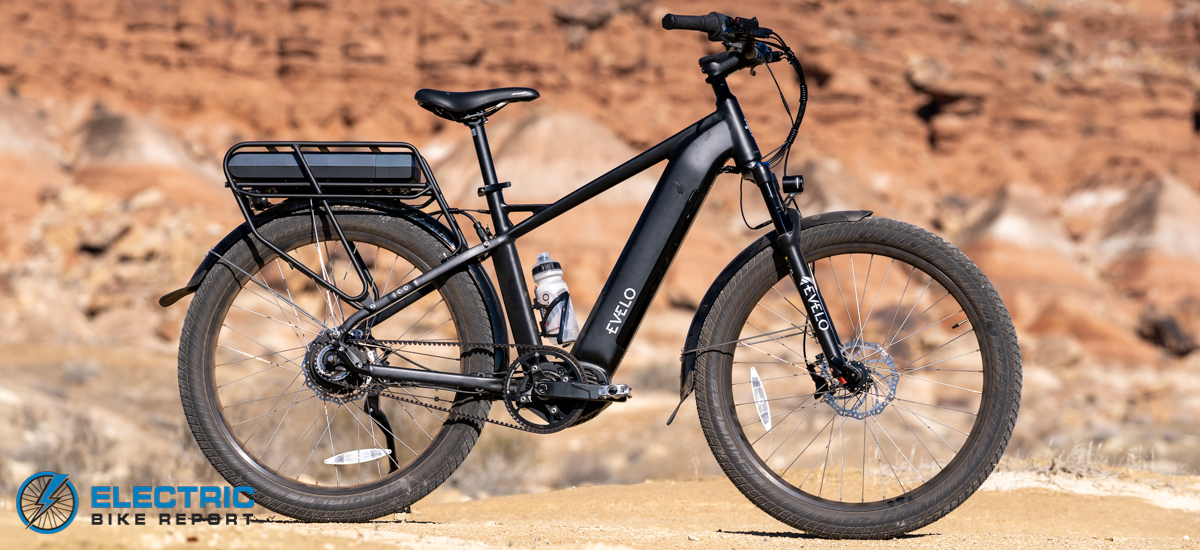
So what makes for a premium commuter that’s fit for touring? The first, most obvious difference is swapping the hub motor for a mid-drive motor mounted in the frame. This is where most of the additional expense goes. Once a manufacturer makes an upgrade of that sort, we often see other upgrades—better brakes, a wider-range drivetrain with more gears (or better yet, a more sophisticated drivetrain altogether), a better quality suspension fork and other little touches, like better lights.
In our Evelo Atlas review we will look at what makes this e-bike so different from its more affordable competitors and why those differences make it worth considering for anyone with a longer commute or interested in possible e-bike tours.
Note: are you looking for similar e-bikes to compare to? The Specialized Turbo Vado is a good option from a well-known name. Another good commuter with touring potential is the Ride1Up Prodigy V2.
 Pro’s
Pro’s- The 600W Bafang mid-drive motor is an incrediblely powerful mid-drive motor for speedy acceleration and the ability to stay at cruising speed on hills
- 720Wh battery is estimated to offer range of up to 60 mi. to give riders more rides between charges
- Optional 696Wh battery can be added to increase range up to 100 mi. (estimated), for riders who want to do touring
- Enviolo planetary gear hub means always having the right gear
- Gates belt drive rather than chain eliminates dirty chain marks on pants and upholstery
- With 120Nm of torque on tap, this e-bike will be a beast on hills
 Con’s
Con’s- The Atlas comes with the option to add a throttle. Many class 1 and 3 e-bikes don’t give you this option, but knowing that the option existed here makes me wish it just came standard instead.
- Battery: 720Wh Samsung
- Display: Bafang full-color IPS display
- Motor: Bafang 600W brushless mid-drive motor producing 120Nm of torque
- Headlight: Integrated 400 Lumens UGOE
- Taillights: Integrated UGOE
- Peal Assist: 5 levels of PAS
- Range: Up to 60 mi. on single battery, second battery can be added
- Throttle: can be added, but not included
- Claimed weight: 66 lbs.
- Maximum rider weight: 350 lbs.
- Maximum load on rear rack:
- Brakes: Zoom hydraulic disc, 180/160mm rotors (front/rear)
- Fenders: Front and rear, included
- Fork: Zoom air/oil suspension
- Frame: Hydroformed 6061 aluminum
- Drivetrain: Enviolo continuously variable transmission with Gates belt
- Grips: Rubber
- Saddle: Selle Royal Freccia with Royal Gel
- Handlebar: Aluminum
- Kickstand: Included
- Pedals: Wellgo alloy with reflectors
- Tires: Schwalbe Moto-X 27.5 x 2.8 in.
Evelo Atlas Review: Bike Overview
That said, such a portrait paints with too broad a brush. The Evelo Atlas features no ordinary mid-drive motor. The Bafang motor produces 600W and 120Nm of torque—numbers that are notably higher than we’ve seen in the great majority of other competitors’ e-bikes. The Bafang motor is powered by a 720Wh Samsung battery for exceptional range.
Another premium feature of the Evelo Atlas is its drivetrain. Rather than being spec’d with a derailleur and rear cogset featuring eight or nine cogs, Evelo chose to go with an Enviolo continuously variable hub which eliminates the need for a messy chain.
And as any premium commuter should include, the Evelo Atlas is equipped with full fenders, a rear rack (which can hold a second battery) and front and rear lights.
Let’s dig into the details.
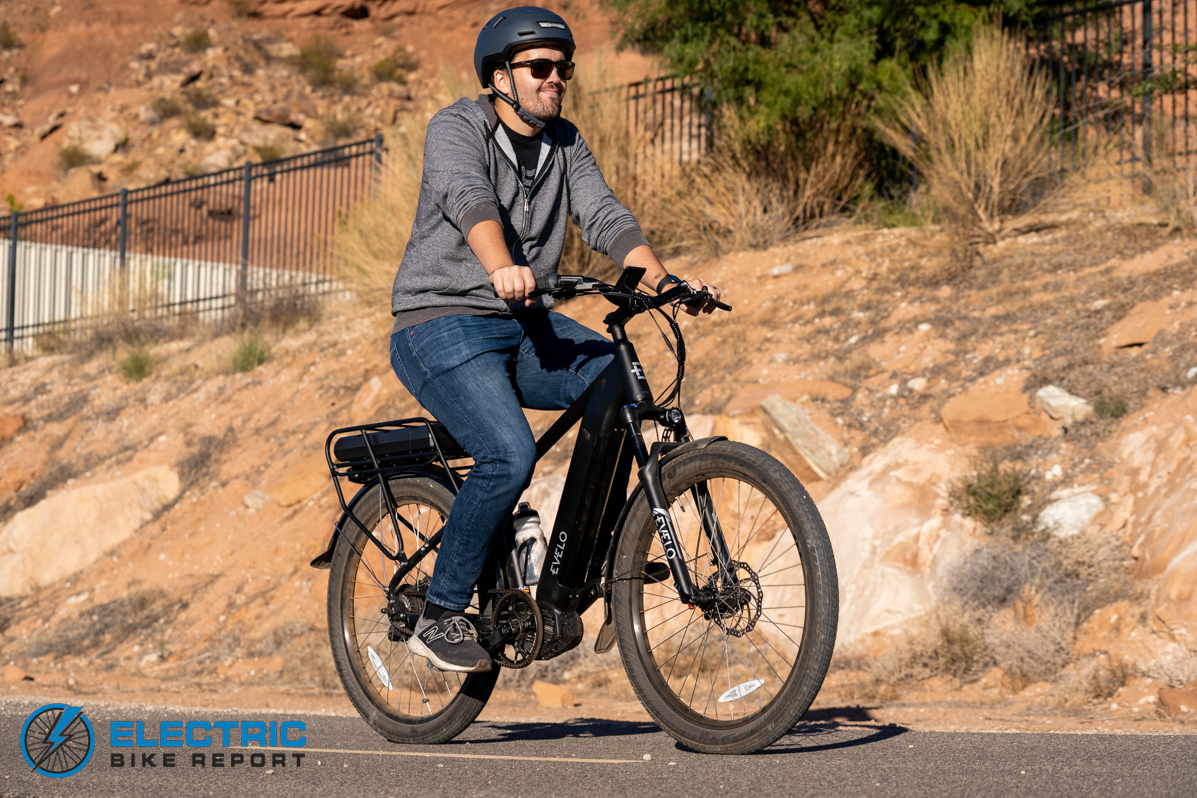
The Evelo Atlas offers a really smooth ride.
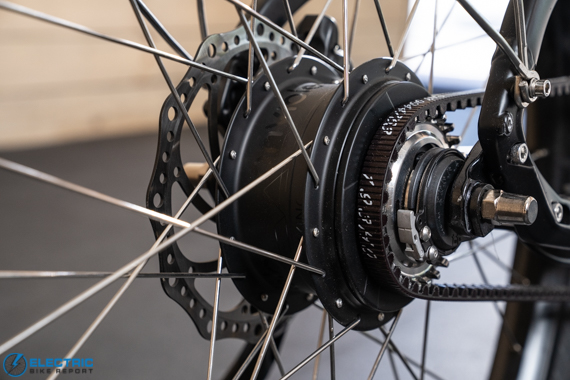
While this looks a a hub motor, it is actually the Enviolo internally geared hub.
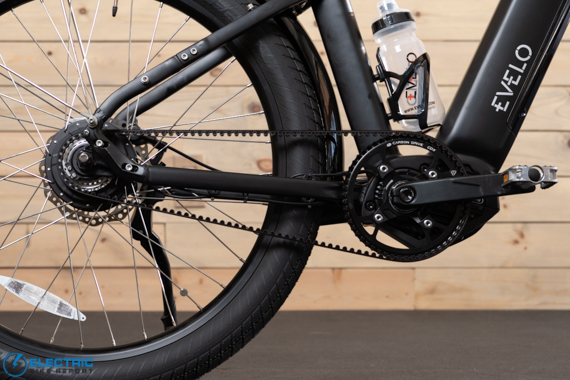
The Gates belt drive is every bit as strong as a chain but never leaves behind a big, black smear on anything it touches.
Evelo Atlas Review: Motor Performance, Speed and Acceleration
On our circuit test, which we conduct on a one-mile loop with four corners and a hill that climbs 40 vertical feet, the Evelo Atlas performed very well. The first thing we noticed was how easy it was to pedal in PAS 0. Our test rider averaged 13.3 mph, which is notably higher than many other e-bikes. Should someone press their luck too far in the range department, being able to pedal home at a reasonable pace will matter.
With the 600W Bafang mid-drive motor in PAS 1, we saw a very powerful average of 17 mph. From there we saw incremental increases of 18.6, 19, and 19.6 mph before it topped out at 20.8 mph in PAS 5.
Because the Evelo Atlas features a mid-drive motor, its power delivery is determined by a torque sensor, not a cadence sensor. Cadence sensors are mostly binary in their function; they monitor whether the rider is pedaling or not. More sensors just means it checks more often. With a torque sensor, a consistent cadence is an important part of getting accurate results and our test rider made sure to pedal at the same pace with each loop.
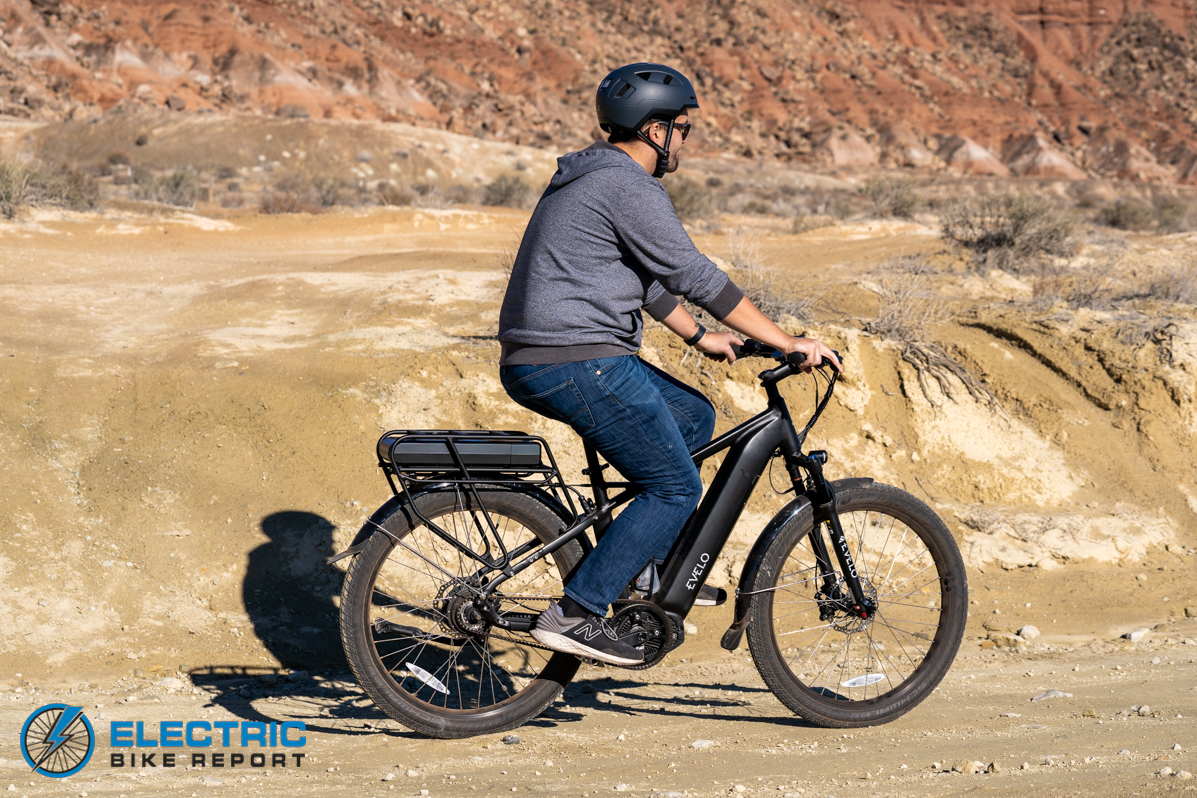
The Evelo Atlas is versatile enough to handle light off-road riding.
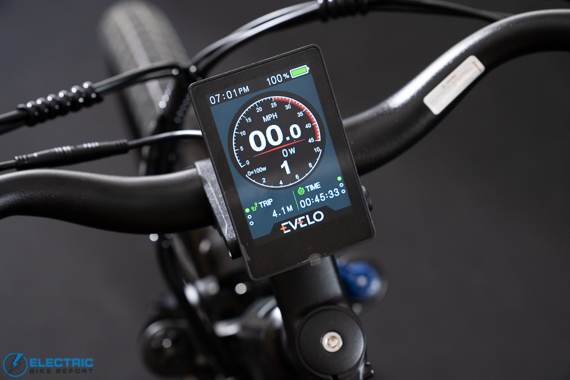
The full-color display is easy to read and offers one of our favorite battery indicators. It looks just like what we see on a smartphone.

The backswept bar allows for a comfortable riding position that doesn’t require the rider to lean forward too far.
Evelo Atlas Review: Range Test & Battery Performance
The range test can be a tricky beast at times. E-bike companies calculate maximum range for their e-bikes based on riding in PAS 1. That’s reasonable, right? However, we have encountered any number of e-bikes that gave precious little assistance in PAS 1. Generally, people don’t buy an e-bike to pedal around at 11 mph. When we have encountered those e-bikes with an underpowered PAS 1, we do our range test at PAS 2 or 3, the point at which we feel the rider really gets the e-bike experience, which is usually around 14 or 15 mph.
The upshot here is that when an e-bike maker claims that their e-bike will cover 60 mi. in a single charge, but their PAS 1 will only help a rider do 11 mph, what they’ve done is effectively artificially boosted the bike’s range. No one wants to ride 60 mi. at 11 mph; we’d be out there all day.
The Evelo Atlas is an antidote to that sort of over-reporting. To recap, on our circuit test, the Evelo Atlas averaged a very capable 17 mph in PAS 1. And like they claim on their website, we covered 60 mi. (60.6, to be precise) on a single charge while riding in PAS 1. It’s not often that we test an e-bike whose capabilities are so accurately reported.
In PAS 5, the Evelo Atlas proved to be impressive as well, covering 32 mi. at an average speed of 19 mph. Anyone with a longer commute will find this e-bike to be a serious contender for their dollars.
One of the abilities that Evelo touts for the Atlas is touring and they back that up by offering buyers the opportunity to buy a second, 696Wh battery which they say will extend the Atlas’ range to 100 mi. It’s not often that an e-bike with such good range affords the opportunity to buy a second battery.
Evelo Atlas Review: Hill Test
Evelo deserves some sort of award for sheer ambition. The Evelo Atlas is built around a 600W Bafang mid-drive motor that produces 120Nm of torque. In terms of torque, it is one of the most powerful mid-drive motors EBR’s reviewed. And while 600W is very powerful for a mid-drive motor, as we’ve noted in other reviews, raw wattage isn’t really the right measure on paper for whether or not an e-bike will climb well.
Torque, that is, the ability for a motor to turn is a much better measure of whether an e-bike will climb well or not and in this regard, the Evelo Atlas has few if any peers. The Bafang motor produces 120Nm of torque, which is substantially higher than most other mid-drive motors and even higher than most hub motors, where high torque numbers are truly critical to an e-bike’s climbing ability.
The Evelo Atlas climbed Hell Hole, our ⅓-mile, 12-percent hill in 1:21, for an average speed of 13.4 mph. This is a pretty mid-pack result—solid, but not impressive. So why didn’t it burn up the asphalt? That’s easy: effort.
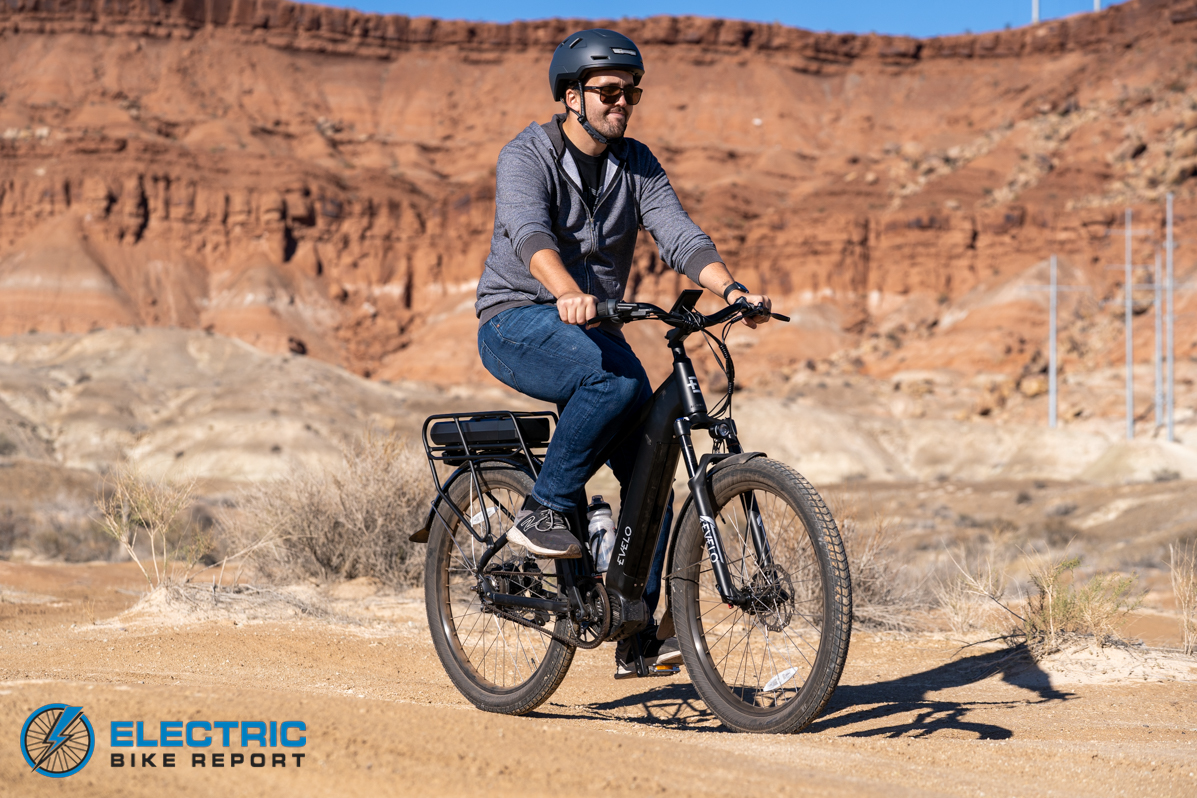
Riders who have range anxiety will love the impressive 60-mile range.
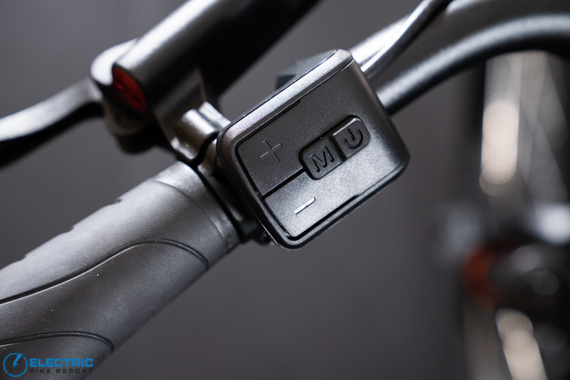
The controller is as easy to use as it is to reach. No pressing buttons on the display.
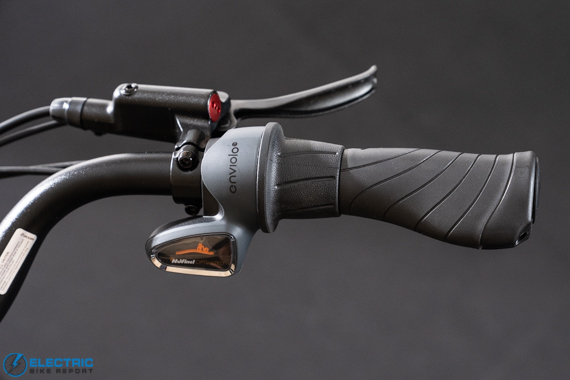
The Enviolo continuously variable hub allows riders to make slight changes to their gearing, with just a slight twist of the shifter.
Simply put, the Evelo Atlas climbed Hell Hole in 1:21 because in our test we only made a moderate effort, not a Tour de France-winning sprint. That’s the beauty of a mid-drive motor.
Evelo Atlas Review: Brakes and the Brake Test
Zoom is a component brand that lacks the cache of Shimano, SRAM or even Tektro, but we have been impressed with their hydraulic disc brakes. Our Evelo Atlas was spec’d with Zoom discs with a 180mm rotor in the front and a 160mm rotor in the rear.
Selecting different rotors for the front and rear is a strategy some manufacturers use in order to improve braking modulation in the rear while reducing the opportunity to lock up the rear wheel in a panic situation.
The Evelo Atlas averaged a stopping distance of 19 feet 3 inches over our three stops, which is a very good performance which impresses us all the more considering we revamped our testing protocol, which has resulted in longer stopping distances overall.
This result is especially noteworthy considering that Evelo says the Atlas can carry riders weighing as much as 350 lbs. Heavier riders will need more distance to come to a stop, so the shorter the stopping distance of a lighter rider, the better for bigger riders.
Evelo Atlas Review: Ride Comfort, Handling and Cockpit
One of the most common wheel sizes for e-bikes is 27.5 in. It’s big enough to roll quickly without unduly elevating standover height, while also offering good maneuverability. Bigger wheels roll over bumps, pavement seams and driveway lips more easily, making for a smoother ride for the rider. The Evelo Atlas sports 27.5-in. wheels shod with 27.5 x 2.8-in.-wide tires. This is one of the wider tires we’ve seen spec’d on 27.5-in. wheels.
Bigger tires do a couple of things to rider comfort. First, a bigger tire can be run at lower tire pressure; that makes the ride smoother and increases traction, while simultaneously reducing the threat of punctures.
The Evelo Atlas looks after rider comfort in some other significant ways, like the air/oil suspension fork (they tend to offer smoother, more fluid operation than suspension forks with coil springs) and the Selle Royal gel-filled saddle, which will offer a cushier place to rest a kiester than some of the saddles we see.
Mid-drive e-bikes handle a bit differently than those with hub motors. It’s not a huge difference, but with the mass of the motor moved forward and closer to the bike’s center of gravity the effect is to make the e-bike feel a bit more intuitive in its handling. The difference isn’t the sort of thing most riders would be able to point to, but in most instances riders moving between two otherwise identical bikes would pick the e-bike with the mid-drive motor.
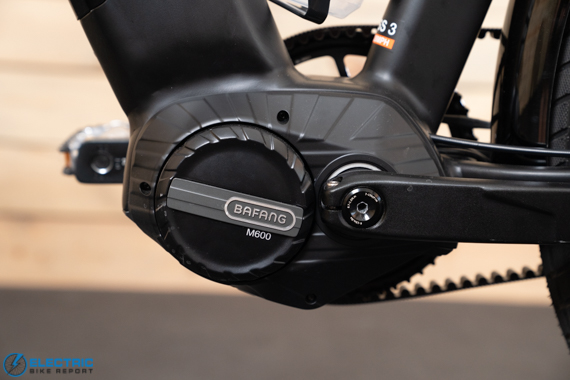
The 600W Bafang motor is one of the most powerful mid-drive motors we’ve encountered.
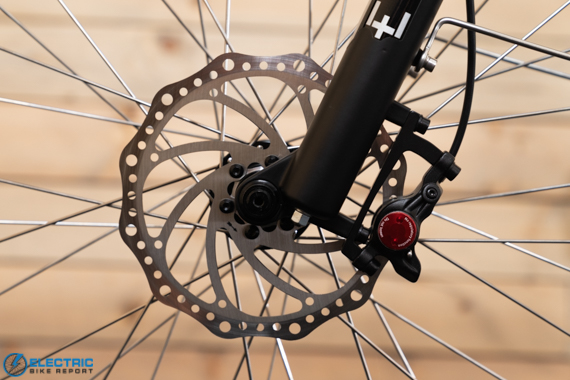
The Zoom hydraulic disc brakes provided excellent braking power and brought the Atlas to a stop quickly.
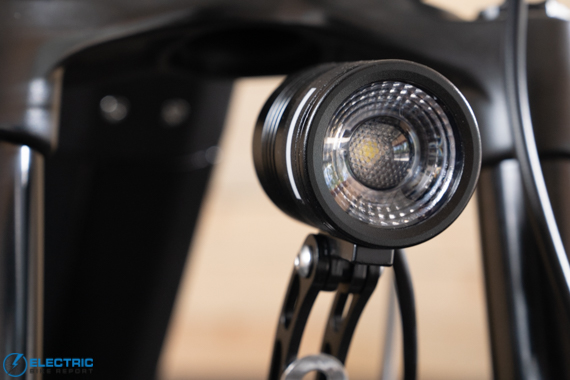
The 400 Lumen UGOE light is brighter than many headlights we see included.
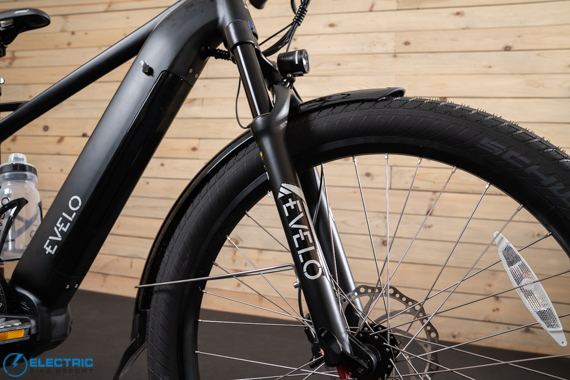
The air/oil suspension fork provides a smoother ride than we with coil spring forks.
Tall riders—anyone north of 6 feet—should take note of the Evelo Atlas. Riders taller than their sizing guidelines are likely taller than the sizing guidelines of a great many other bikes but may find the reach to be more forgiving to their back and arms.
The 2.8-in.-wide Schwalbe tires not only increase rider comfort compared to narrower tires, they make the Atlas’ handling calm and predictable—more SUV than compact car.
Another significant feature of the Evelo Atlas, and one of the reasons this e-bike goes for more than $4000 is the Enviolo drivetrain. Unlike traditional derailleur systems, the Enviolo drivetrain features a planetary gear system contained within the rear hub. A cable runs from the hub to a twist shifter mounted on the handlebar. The system offers a wider range of gears than is found with most derailleur systems which means having the right gear for any hill.
The Enviolo hub is paired with a Gates belt which eliminates unsightly marks left on anything the chain might touch. That also means no chain lube—ever. The sheer reduction in maintenance (and OxyClean) easily justifies the expense.
The Bafang full-color display is sizable and mounted at the center of the bar, making it easy to read at a glance. One of our favorite features was its use of a battery icon with a numerical percentage next to it so that the rider can see down to a single percentage point just how much charge is left in the battery—just like a smartphone. Now if we could just get other brands to copy this feature.
Evelo Atlas Review: Summary / Where to Buy
What Evelo has created with the Atlas is a commuter with an unusual degree of muscle. Were we putting together a collection of e-bikes for big and tall riders, the Atlas would definitely make the cut. The combination of a 350-lb. payload limit, a big battery, stout hydraulic brakes and a 600W mid-drive motor that produces 120Nm of torque make this e-bike an exceptional offering for anyone who has found other e-bikes lacking in muscle.
Here’s another way to frame just how good this e-bike is: We are wondering why they haven’t taken this exact same parts package and built it into a long-tail cargo e-bike. The Atlas’ parts pick would make for an exceptional cargo e-bike.
For anyone nonplussed by the Atlas’ performance on Hell Hole we would remind readers that the mid-drive motor multiplies a rider’s effort and if a rider doesn’t go very hard, the motor won’t go very hard. Were we to go back and take our frustrations out on the hill, there’s a fair chance the Evelo Atlas would record some of the best numbers we’ve seen.
Evelo’s website suggests the Atlas can be ridden on light trails and unpaved roads. We would emphasize the word “light.” There isn’t much clearance between the 2.8-in.-wide tires and the fenders, which would pose a problem in muddy conditions and the tires themselves are not especially knobby, so we would steer riders away from any surfaces that are soft or sandy.
The Bafang display is bright, easy to read and in featuring a battery icon and a numerical percentage to let the rider know exactly how much of the battery’s charge remains, it highlights a frustration we’ve experienced with most other displays. It’s just the sort of touch that makes us look at all the others and grumble, “That’s how it’s done.”
Anyone who has ever worried about the real-world range of an e-bike, especially those among us who might occasionally forget to charge our e-bike overnight, can rejoice at the insurance that the Evelo Atlas offers. And if for some reason the 720Wh Samsung battery falls short of someone’s need, there’s the option to order a second battery offering 696Wh. It’s like the World Series of win-wins.
We don’t often see e-bikes from direct-to-consumer companies that can go head-to-head with the offerings from brands like Specialized and Trek, but the Evelo Atlas does exactly that. And in saying it can compete with e-bikes from Trek and Specialized, that may be the best compliment we can pay the Evelo Atlas.
‘Happy Riding, make sure to let us know if you have any questions down in our comments section or if you think we left anything out in this review of the Evelo Atlas.



Great review! Please do a special on long range touring bikes as 100+ per day is readily achievable with a good quality e-bike. Thanks!
Class 1 and 3 e-bikes aren’t supposed to give you a throttle option!
That is reserved for 20mph Class 2 bikes only. Manufacturers / home builders that add one are taking us down the path where a new Class level will be added, likely with registration and licensing, as in Europe.
A bike this heavy, especially if loaded for touring with dual batteries and a large rider, needs far better brakes. 200 front and 180 rear, with teeth like the Magura 5.
And, being for touring, some specs on the light, along with distance / pattern test results, would be helpful.
It would have been interesting to see what the bike could do with max effort.In any case, it seems more like a Toyota Camry than a Lexus which makes the price way too high. It shouldn’t be higher than $2995 IMO.